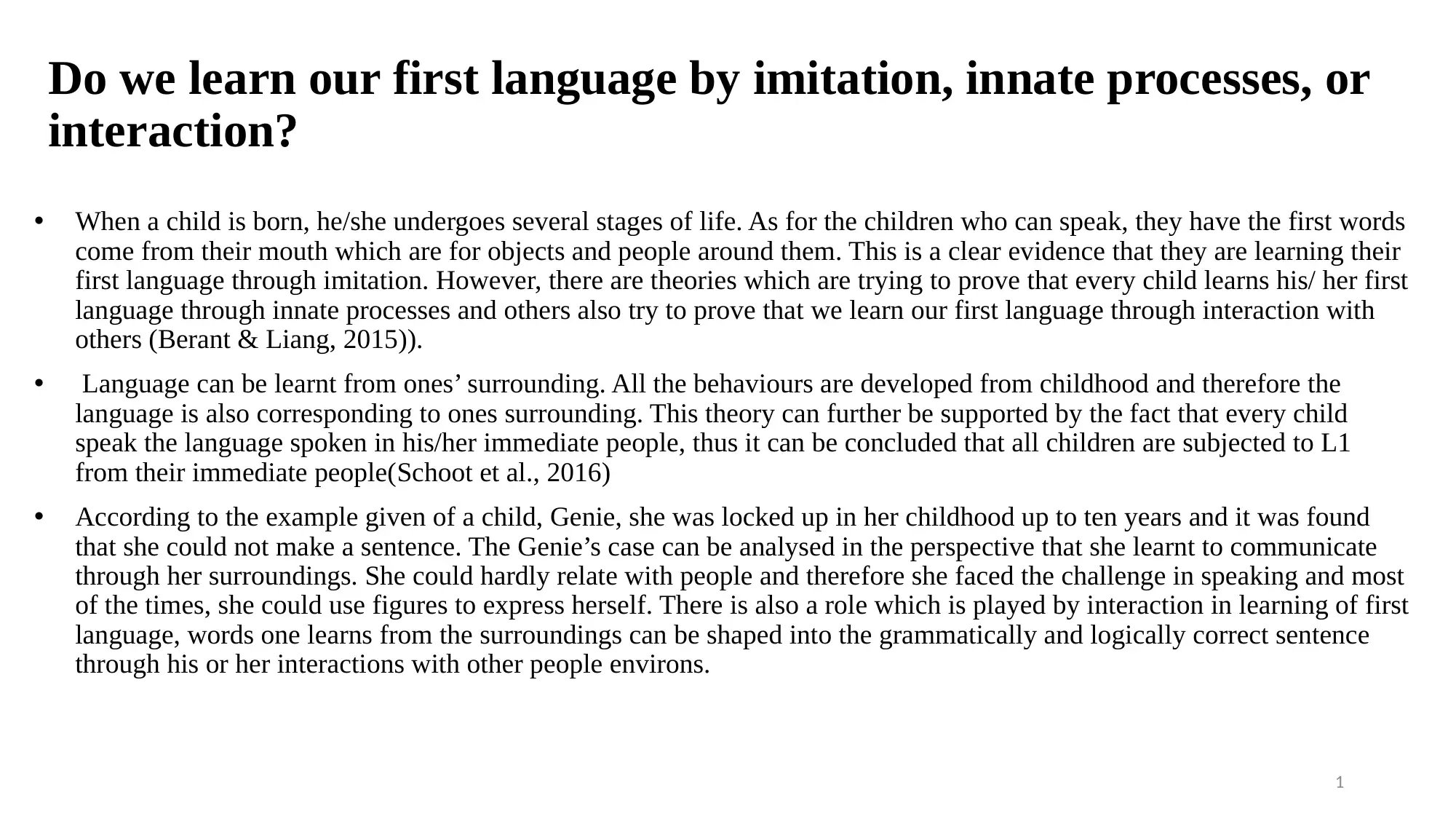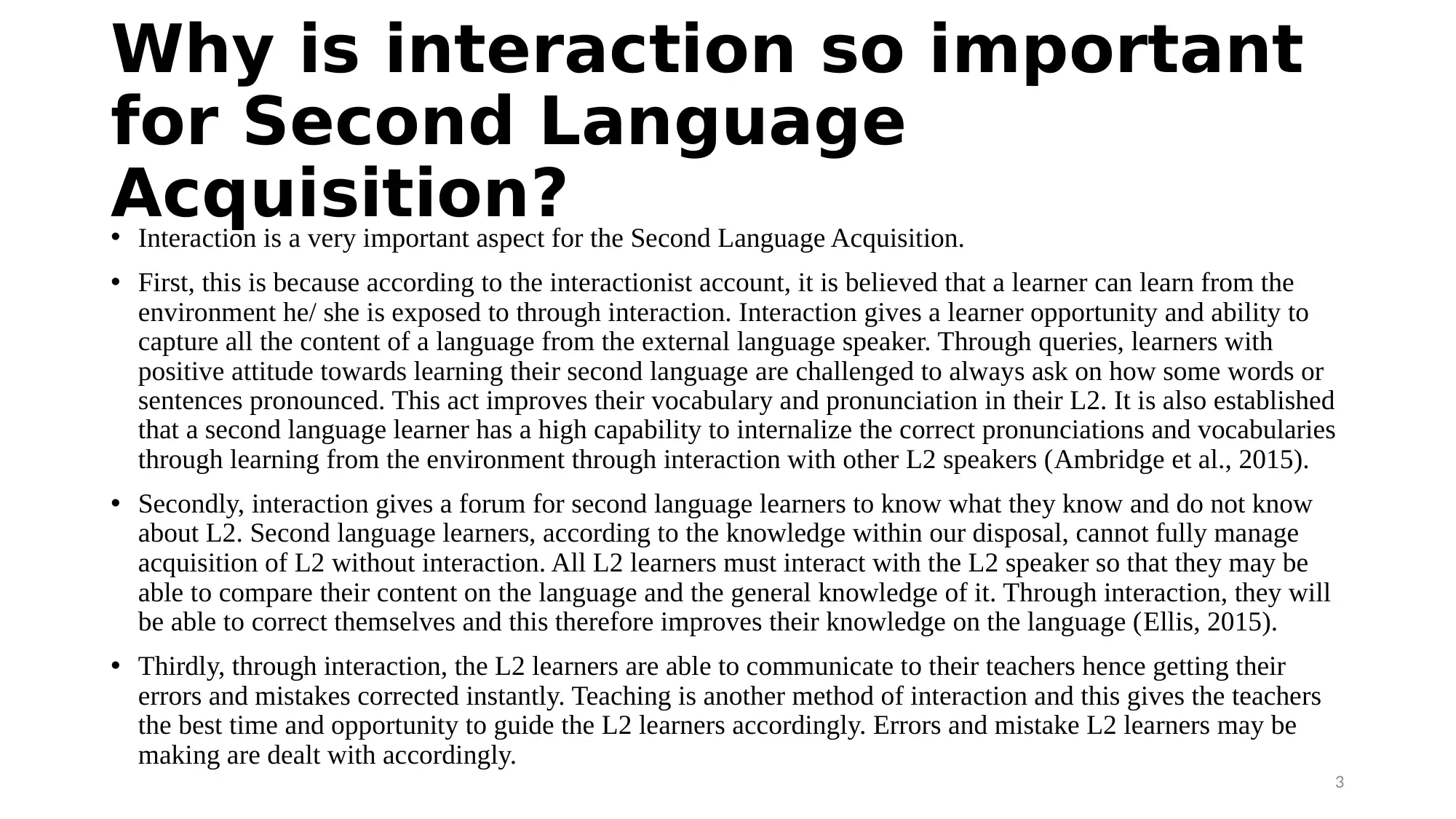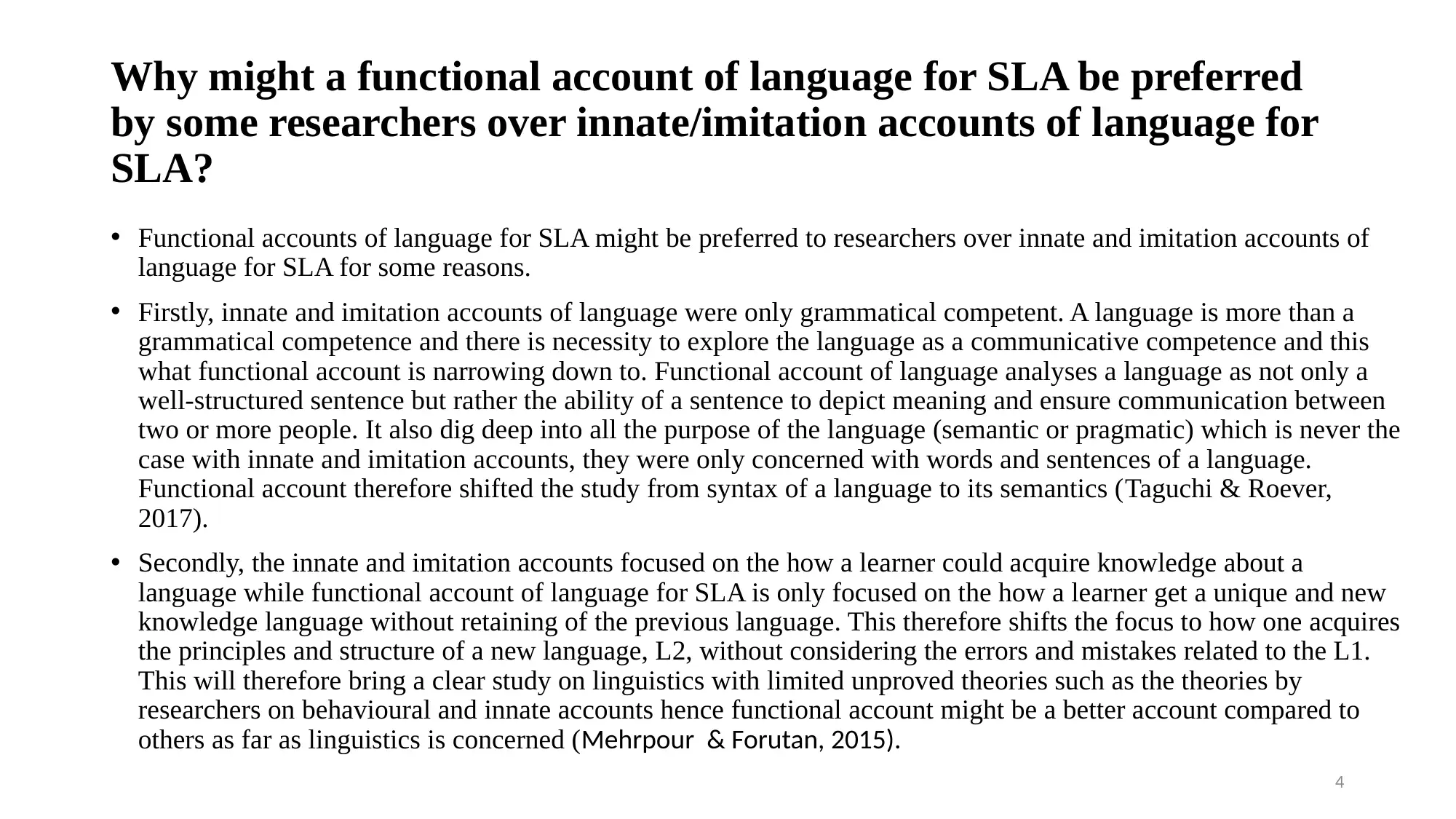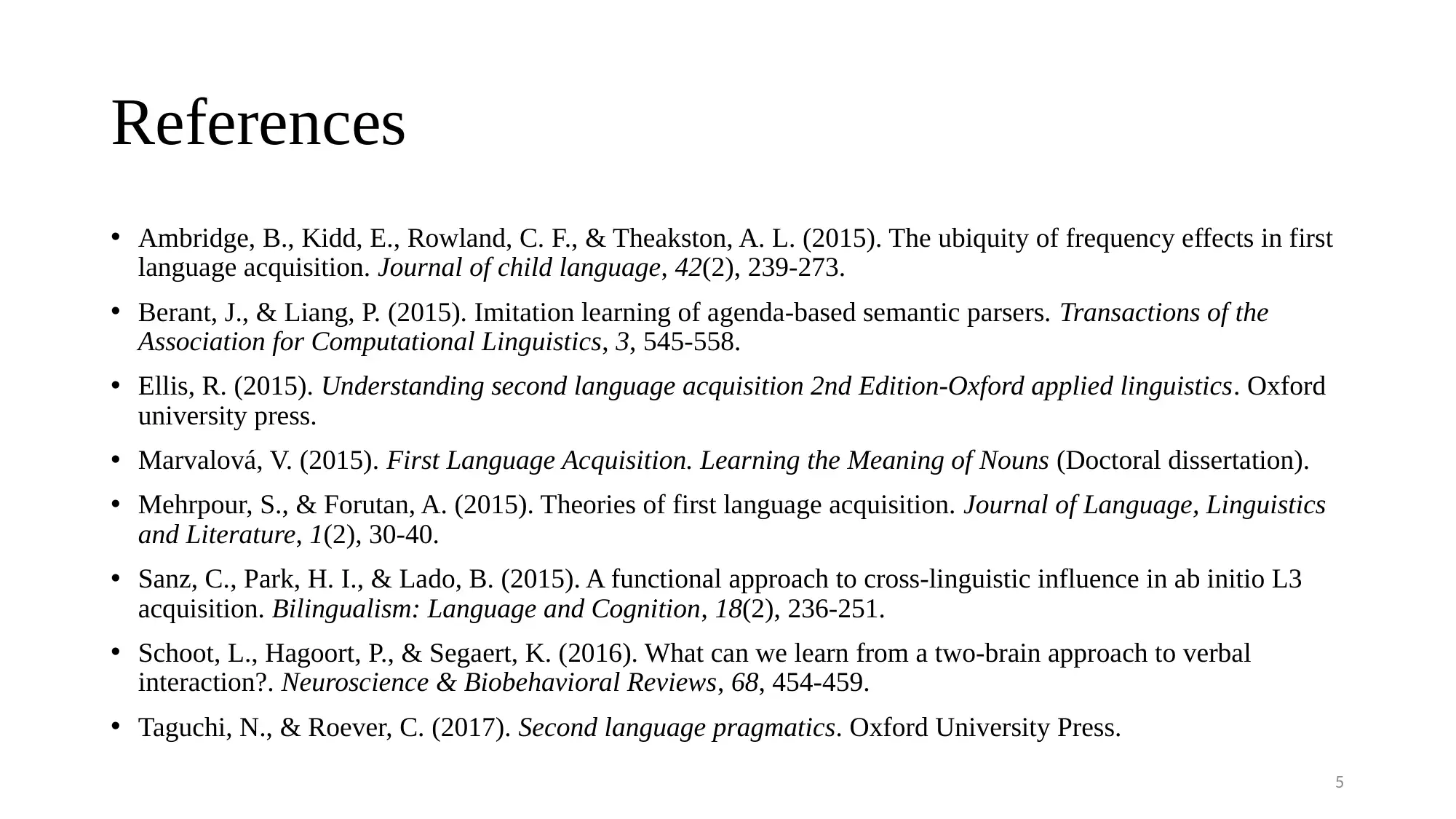First Language Acquisition: Theories of Language Development
VerifiedAdded on 2022/09/14
|5
|1486
|11
Essay
AI Summary
This essay delves into the complexities of first language acquisition, examining whether it primarily stems from imitation, innate processes, or interaction. It presents arguments for and against each perspective, drawing on examples and research to support its claims. The essay further explores the Universal Grammar (UG) approach to Second Language Acquisition (SLA), critiquing its limitations and discussing the role of interaction in SLA. It then contrasts functional, innate, and imitation accounts of language for SLA, explaining why some researchers prefer functional accounts. The essay provides a comprehensive overview of the major theories and debates in language acquisition, offering valuable insights into how humans learn to communicate.

1
Do we learn our first language by imitation, innate processes, or
interaction?
• When a child is born, he/she undergoes several stages of life. As for the children who can speak, they have the first words
come from their mouth which are for objects and people around them. This is a clear evidence that they are learning their
first language through imitation. However, there are theories which are trying to prove that every child learns his/ her first
language through innate processes and others also try to prove that we learn our first language through interaction with
others (Berant & Liang, 2015)).
• Language can be learnt from ones’ surrounding. All the behaviours are developed from childhood and therefore the
language is also corresponding to ones surrounding. This theory can further be supported by the fact that every child
speak the language spoken in his/her immediate people, thus it can be concluded that all children are subjected to L1
from their immediate people(Schoot et al., 2016)
• According to the example given of a child, Genie, she was locked up in her childhood up to ten years and it was found
that she could not make a sentence. The Genie’s case can be analysed in the perspective that she learnt to communicate
through her surroundings. She could hardly relate with people and therefore she faced the challenge in speaking and most
of the times, she could use figures to express herself. There is also a role which is played by interaction in learning of first
language, words one learns from the surroundings can be shaped into the grammatically and logically correct sentence
through his or her interactions with other people environs.
Do we learn our first language by imitation, innate processes, or
interaction?
• When a child is born, he/she undergoes several stages of life. As for the children who can speak, they have the first words
come from their mouth which are for objects and people around them. This is a clear evidence that they are learning their
first language through imitation. However, there are theories which are trying to prove that every child learns his/ her first
language through innate processes and others also try to prove that we learn our first language through interaction with
others (Berant & Liang, 2015)).
• Language can be learnt from ones’ surrounding. All the behaviours are developed from childhood and therefore the
language is also corresponding to ones surrounding. This theory can further be supported by the fact that every child
speak the language spoken in his/her immediate people, thus it can be concluded that all children are subjected to L1
from their immediate people(Schoot et al., 2016)
• According to the example given of a child, Genie, she was locked up in her childhood up to ten years and it was found
that she could not make a sentence. The Genie’s case can be analysed in the perspective that she learnt to communicate
through her surroundings. She could hardly relate with people and therefore she faced the challenge in speaking and most
of the times, she could use figures to express herself. There is also a role which is played by interaction in learning of first
language, words one learns from the surroundings can be shaped into the grammatically and logically correct sentence
through his or her interactions with other people environs.
Paraphrase This Document
Need a fresh take? Get an instant paraphrase of this document with our AI Paraphraser

2
What evidence is there to support / not support a UG-
based account of SLA?
• Universal grammar (UG) is an approach with several limitations to linguistics. For this reason I cannot agree with it.
UG is only concerned in a research about what a language constitutes and not how one can learn the language. The
major objective of a linguistic research should first be how one learns a language and thereafter learn on what
constitutes the language.
• According to the studies of Chomsky which creates a ground on UG, he indicates that learning a language is innate.
Although he never gives the relevance on this theory on the second language learners, he gives a clear explanation that
all children learn and never accept corrections and rather formulates their own principles and grammatical standards of
a language. However, there are many unanswered questions about how UG approach on ESL learners. These learners
are undergoing several challenges while learning L2 and this starts when they learn on some words on the L2. An L2
learner does not have to undergo a fully structured structure of learning L1 in order to get ability to learn L2 but rather,
he/ she has the capability to learn L2 the same way he/ she learnt L1 (Sanz et al., 2015).
• Moreover, UG is focused on building a linguistic competence using researchers’ intuitions which cannot be depended
on. These intuitions are just ideologies of the researchers which cannot be practically approved. It is therefore very
unreliable to set some theoretical conclusions from unreliable methods of research and intuitions. Linguists require
reliable evidence to support a principle or theory to establish a competent approach (Marvalová, 2015).
What evidence is there to support / not support a UG-
based account of SLA?
• Universal grammar (UG) is an approach with several limitations to linguistics. For this reason I cannot agree with it.
UG is only concerned in a research about what a language constitutes and not how one can learn the language. The
major objective of a linguistic research should first be how one learns a language and thereafter learn on what
constitutes the language.
• According to the studies of Chomsky which creates a ground on UG, he indicates that learning a language is innate.
Although he never gives the relevance on this theory on the second language learners, he gives a clear explanation that
all children learn and never accept corrections and rather formulates their own principles and grammatical standards of
a language. However, there are many unanswered questions about how UG approach on ESL learners. These learners
are undergoing several challenges while learning L2 and this starts when they learn on some words on the L2. An L2
learner does not have to undergo a fully structured structure of learning L1 in order to get ability to learn L2 but rather,
he/ she has the capability to learn L2 the same way he/ she learnt L1 (Sanz et al., 2015).
• Moreover, UG is focused on building a linguistic competence using researchers’ intuitions which cannot be depended
on. These intuitions are just ideologies of the researchers which cannot be practically approved. It is therefore very
unreliable to set some theoretical conclusions from unreliable methods of research and intuitions. Linguists require
reliable evidence to support a principle or theory to establish a competent approach (Marvalová, 2015).

3
Why is interaction so important
for Second Language
Acquisition?• Interaction is a very important aspect for the Second Language Acquisition.
• First, this is because according to the interactionist account, it is believed that a learner can learn from the
environment he/ she is exposed to through interaction. Interaction gives a learner opportunity and ability to
capture all the content of a language from the external language speaker. Through queries, learners with
positive attitude towards learning their second language are challenged to always ask on how some words or
sentences pronounced. This act improves their vocabulary and pronunciation in their L2. It is also established
that a second language learner has a high capability to internalize the correct pronunciations and vocabularies
through learning from the environment through interaction with other L2 speakers (Ambridge et al., 2015).
• Secondly, interaction gives a forum for second language learners to know what they know and do not know
about L2. Second language learners, according to the knowledge within our disposal, cannot fully manage
acquisition of L2 without interaction. All L2 learners must interact with the L2 speaker so that they may be
able to compare their content on the language and the general knowledge of it. Through interaction, they will
be able to correct themselves and this therefore improves their knowledge on the language (Ellis, 2015).
• Thirdly, through interaction, the L2 learners are able to communicate to their teachers hence getting their
errors and mistakes corrected instantly. Teaching is another method of interaction and this gives the teachers
the best time and opportunity to guide the L2 learners accordingly. Errors and mistake L2 learners may be
making are dealt with accordingly.
Why is interaction so important
for Second Language
Acquisition?• Interaction is a very important aspect for the Second Language Acquisition.
• First, this is because according to the interactionist account, it is believed that a learner can learn from the
environment he/ she is exposed to through interaction. Interaction gives a learner opportunity and ability to
capture all the content of a language from the external language speaker. Through queries, learners with
positive attitude towards learning their second language are challenged to always ask on how some words or
sentences pronounced. This act improves their vocabulary and pronunciation in their L2. It is also established
that a second language learner has a high capability to internalize the correct pronunciations and vocabularies
through learning from the environment through interaction with other L2 speakers (Ambridge et al., 2015).
• Secondly, interaction gives a forum for second language learners to know what they know and do not know
about L2. Second language learners, according to the knowledge within our disposal, cannot fully manage
acquisition of L2 without interaction. All L2 learners must interact with the L2 speaker so that they may be
able to compare their content on the language and the general knowledge of it. Through interaction, they will
be able to correct themselves and this therefore improves their knowledge on the language (Ellis, 2015).
• Thirdly, through interaction, the L2 learners are able to communicate to their teachers hence getting their
errors and mistakes corrected instantly. Teaching is another method of interaction and this gives the teachers
the best time and opportunity to guide the L2 learners accordingly. Errors and mistake L2 learners may be
making are dealt with accordingly.
⊘ This is a preview!⊘
Do you want full access?
Subscribe today to unlock all pages.

Trusted by 1+ million students worldwide

4
Why might a functional account of language for SLA be preferred
by some researchers over innate/imitation accounts of language for
SLA?
• Functional accounts of language for SLA might be preferred to researchers over innate and imitation accounts of
language for SLA for some reasons.
• Firstly, innate and imitation accounts of language were only grammatical competent. A language is more than a
grammatical competence and there is necessity to explore the language as a communicative competence and this
what functional account is narrowing down to. Functional account of language analyses a language as not only a
well-structured sentence but rather the ability of a sentence to depict meaning and ensure communication between
two or more people. It also dig deep into all the purpose of the language (semantic or pragmatic) which is never the
case with innate and imitation accounts, they were only concerned with words and sentences of a language.
Functional account therefore shifted the study from syntax of a language to its semantics (Taguchi & Roever,
2017).
• Secondly, the innate and imitation accounts focused on the how a learner could acquire knowledge about a
language while functional account of language for SLA is only focused on the how a learner get a unique and new
knowledge language without retaining of the previous language. This therefore shifts the focus to how one acquires
the principles and structure of a new language, L2, without considering the errors and mistakes related to the L1.
This will therefore bring a clear study on linguistics with limited unproved theories such as the theories by
researchers on behavioural and innate accounts hence functional account might be a better account compared to
others as far as linguistics is concerned (Mehrpour & Forutan, 2015).
Why might a functional account of language for SLA be preferred
by some researchers over innate/imitation accounts of language for
SLA?
• Functional accounts of language for SLA might be preferred to researchers over innate and imitation accounts of
language for SLA for some reasons.
• Firstly, innate and imitation accounts of language were only grammatical competent. A language is more than a
grammatical competence and there is necessity to explore the language as a communicative competence and this
what functional account is narrowing down to. Functional account of language analyses a language as not only a
well-structured sentence but rather the ability of a sentence to depict meaning and ensure communication between
two or more people. It also dig deep into all the purpose of the language (semantic or pragmatic) which is never the
case with innate and imitation accounts, they were only concerned with words and sentences of a language.
Functional account therefore shifted the study from syntax of a language to its semantics (Taguchi & Roever,
2017).
• Secondly, the innate and imitation accounts focused on the how a learner could acquire knowledge about a
language while functional account of language for SLA is only focused on the how a learner get a unique and new
knowledge language without retaining of the previous language. This therefore shifts the focus to how one acquires
the principles and structure of a new language, L2, without considering the errors and mistakes related to the L1.
This will therefore bring a clear study on linguistics with limited unproved theories such as the theories by
researchers on behavioural and innate accounts hence functional account might be a better account compared to
others as far as linguistics is concerned (Mehrpour & Forutan, 2015).
Paraphrase This Document
Need a fresh take? Get an instant paraphrase of this document with our AI Paraphraser

5
References
• Ambridge, B., Kidd, E., Rowland, C. F., & Theakston, A. L. (2015). The ubiquity of frequency effects in first
language acquisition. Journal of child language, 42(2), 239-273.
• Berant, J., & Liang, P. (2015). Imitation learning of agenda-based semantic parsers. Transactions of the
Association for Computational Linguistics, 3, 545-558.
• Ellis, R. (2015). Understanding second language acquisition 2nd Edition-Oxford applied linguistics. Oxford
university press.
• Marvalová, V. (2015). First Language Acquisition. Learning the Meaning of Nouns (Doctoral dissertation).
• Mehrpour, S., & Forutan, A. (2015). Theories of first language acquisition. Journal of Language, Linguistics
and Literature, 1(2), 30-40.
• Sanz, C., Park, H. I., & Lado, B. (2015). A functional approach to cross-linguistic influence in ab initio L3
acquisition. Bilingualism: Language and Cognition, 18(2), 236-251.
• Schoot, L., Hagoort, P., & Segaert, K. (2016). What can we learn from a two-brain approach to verbal
interaction?. Neuroscience & Biobehavioral Reviews, 68, 454-459.
• Taguchi, N., & Roever, C. (2017). Second language pragmatics. Oxford University Press.
References
• Ambridge, B., Kidd, E., Rowland, C. F., & Theakston, A. L. (2015). The ubiquity of frequency effects in first
language acquisition. Journal of child language, 42(2), 239-273.
• Berant, J., & Liang, P. (2015). Imitation learning of agenda-based semantic parsers. Transactions of the
Association for Computational Linguistics, 3, 545-558.
• Ellis, R. (2015). Understanding second language acquisition 2nd Edition-Oxford applied linguistics. Oxford
university press.
• Marvalová, V. (2015). First Language Acquisition. Learning the Meaning of Nouns (Doctoral dissertation).
• Mehrpour, S., & Forutan, A. (2015). Theories of first language acquisition. Journal of Language, Linguistics
and Literature, 1(2), 30-40.
• Sanz, C., Park, H. I., & Lado, B. (2015). A functional approach to cross-linguistic influence in ab initio L3
acquisition. Bilingualism: Language and Cognition, 18(2), 236-251.
• Schoot, L., Hagoort, P., & Segaert, K. (2016). What can we learn from a two-brain approach to verbal
interaction?. Neuroscience & Biobehavioral Reviews, 68, 454-459.
• Taguchi, N., & Roever, C. (2017). Second language pragmatics. Oxford University Press.
1 out of 5
Related Documents
Your All-in-One AI-Powered Toolkit for Academic Success.
+13062052269
info@desklib.com
Available 24*7 on WhatsApp / Email
![[object Object]](/_next/static/media/star-bottom.7253800d.svg)
Unlock your academic potential
Copyright © 2020–2025 A2Z Services. All Rights Reserved. Developed and managed by ZUCOL.





